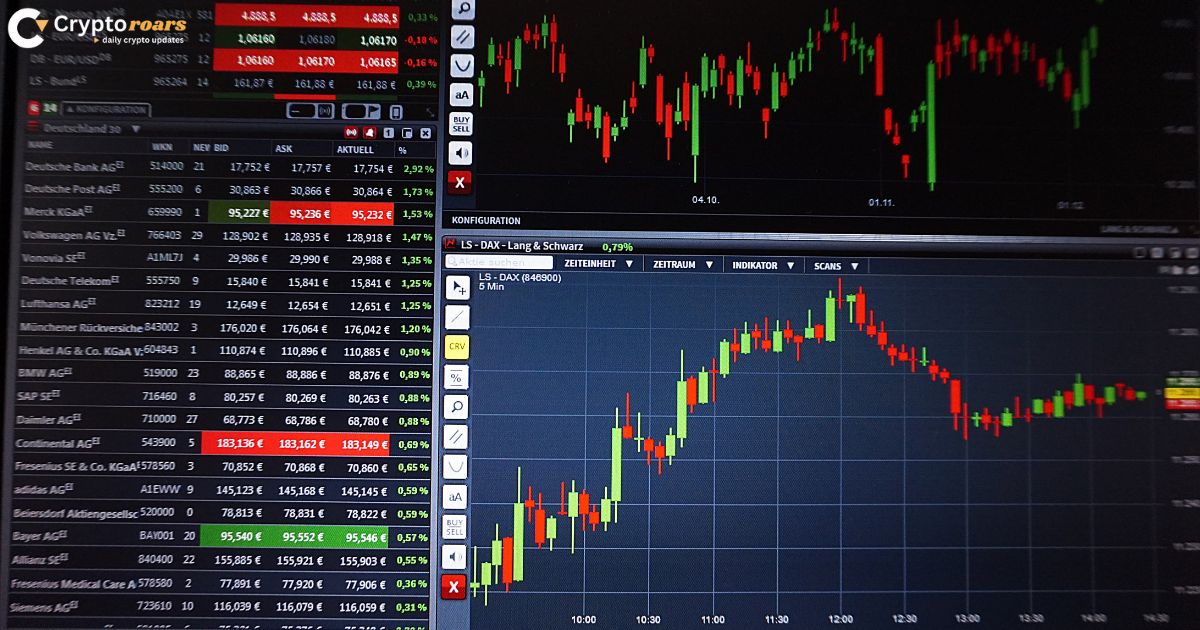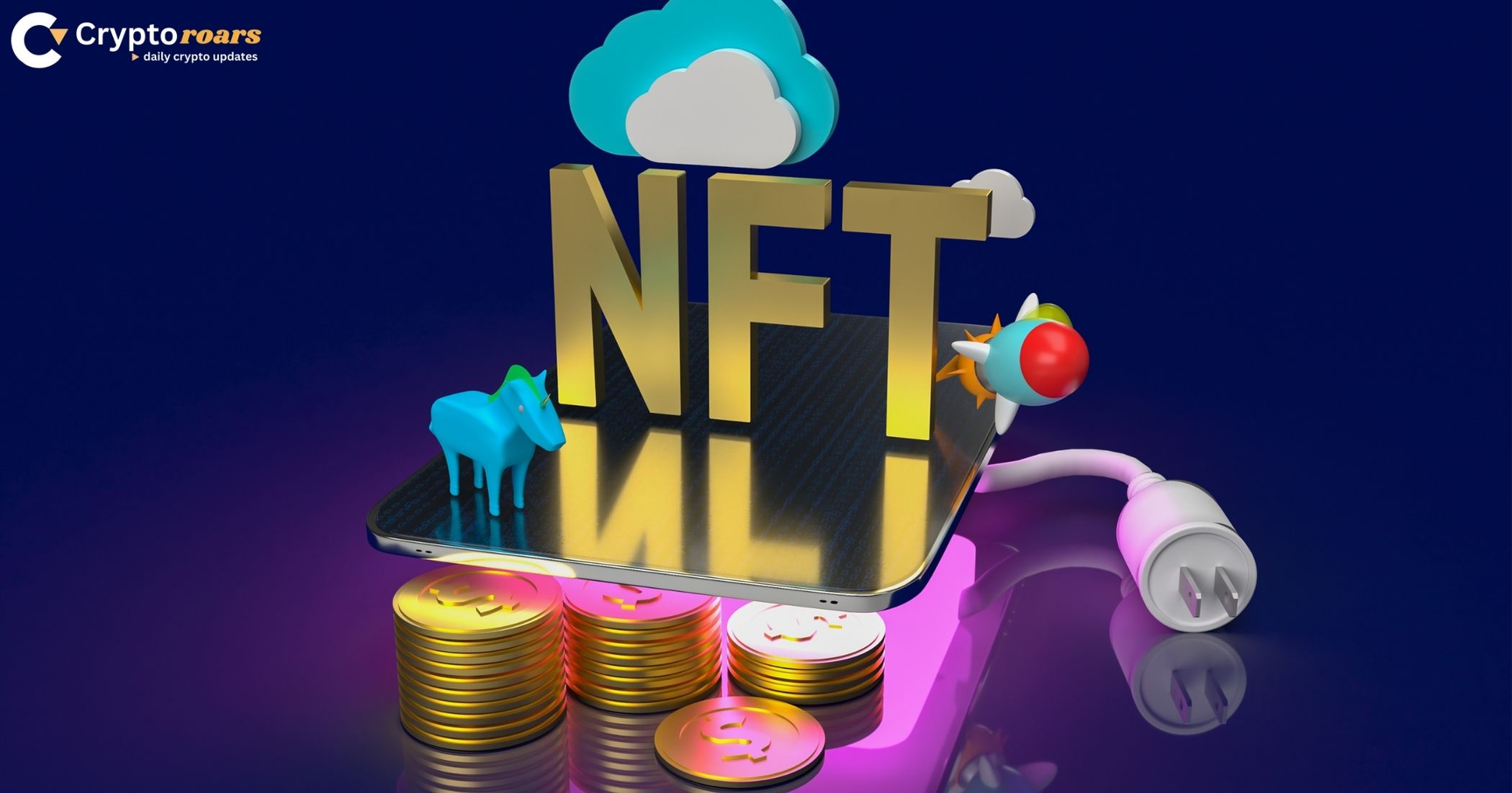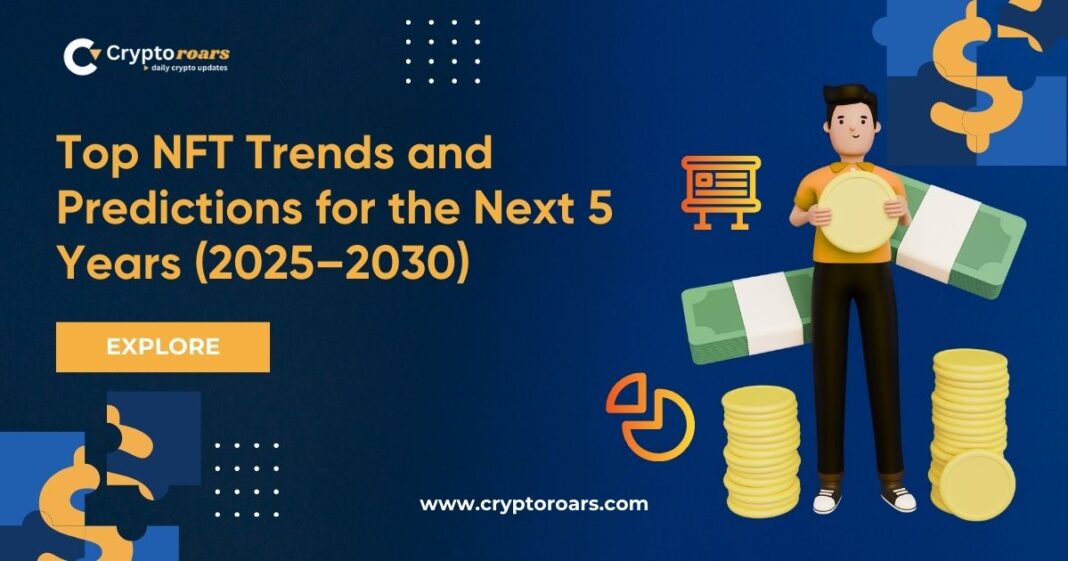Introduction to the Top NFT Trends and Predictions
The Top NFT trends and predictions for the next five years are shaping a digital revolution that continues to evolve across the United States and beyond. The digital collectibles market, once seen as an experimental niche, has transformed into a powerful ecosystem supported by blockchain technology, virtual assets, and a thriving cryptocurrency market. Over the last decade, NFTs have changed the way we think about digital ownership, creating opportunities for individuals and institutions to trade, invest, and build value through peer-to-peer trading in virtual marketplaces.
As Web3 moves deeper into American culture, NFTs are not only collectibles but also tools for tokenization, decentralized marketplace development, and provenance verification of assets. The future landscape will be defined by market dynamics, adoption curves, and growth trajectories that will highlight the role of NFTs in reshaping the digital art market, the metaverse integration, and even blockchain gaming. By 2030, experts expect the NFT ecosystem in the USA to become a core component of both the crypto investment sector and traditional finance.
Evolution of NFTs: From Collectibles to Utility
The first phase of NFTs was heavily centered around collectible trading, often linked to the boom of digital art market projects like CryptoPunks and Bored Ape Yacht Club. These projects created a global fascination with digital scarcity and digital authenticity, supported by immutable records on blockchain protocols. However, the next five years will be far more utility-driven. Top NFT trends and predictions suggest that NFTs will expand into areas such as smart contracts for event tickets, real estate asset tokenization, and business licensing.
Utility NFTs also play a key role in strengthening market psychology as buyers look beyond hype and focus on real-world benefits. According to market trends analysis, more U.S. companies are experimenting with NFTs as membership passes, loyalty rewards, and identity verification systems. These examples showcase how market segmentation and user behavior patterns will shape the transition from art-centric NFTs to fully functional virtual assets that integrate with both online and offline experiences.
Statistical Projections and Market Forecasts (2025–2030)

The Top NFT trends and predictions cannot be understood without hard numbers. A growing body of data-driven insights suggests that the global NFT market could reach over $200 billion by 2030, with the USA maintaining a strong lead due to advanced blockchain protocols, high Web3 adoption, and a mature crypto trading infrastructure. This growth aligns with predictive analytics, market forecasting, and quantitative analysis models that point toward an accelerated rise in both institutional and individual participation.
A comparison of future valuations illustrates this growth clearly:
| Year | Estimated Global NFT Market Value | U.S. Share of Market |
| 2025 | $70 Billion | 45% |
| 2027 | $125 Billion | 47% |
| 2030 | $210 Billion | 50% |
This table demonstrates how performance metrics, market indicators, and trend identification highlight the USA’s stronghold in NFT adoption. The combination of volatility modeling, correlation analysis, and statistical modeling confirms a steady upward trend, even as global markets undergo shifts in cryptographic security and regulatory frameworks.
Expert Opinions: What Industry Leaders Say About NFTs
Prominent figures in the NFT and cryptocurrency market have made bold statements about what the next five years may look like. U.S. venture capitalist Chris Dixon from Andreessen Horowitz has said, “NFTs are not just about art; they are about everything we own becoming programmable.” This reflects the industry’s confidence in token economics and decentralized finance integration. Many leaders argue that NFTs will serve as the backbone of digital provenance in areas like education certificates, health records, and virtual economies.
Still, skepticism remains among some experts who point to challenges in risk assessment, behavioral analysis, and sentiment analysis of the crypto investment community. They argue that market dynamics may be unstable due to regulatory uncertainties. Nevertheless, the overwhelming consensus among thought leaders is that blockchain technology will continue to provide provenance verification and distributed ledger innovations that ensure NFTs remain central to Web3.
NFT Collectibles Market: Current Status and Future Outlook
The current state of NFT collectibles in the USA is fascinating. Popular collections such as CryptoPunks, Pudgy Penguins, and Bored Ape Yacht Club have created cultural icons, while also shaping new market indicators. Analysts note that these collections thrive on digital scarcity, pattern recognition in pricing, and fundamental analysis of rarity and demand. The next stage of the collectibles market is predicted to expand into digital authenticity tied to lifestyle brands and real-world perks.
Looking ahead, market trends analysis suggests the U.S. collectibles space will grow by merging with sports, film, and mainstream entertainment. Case studies show that American sports franchises are launching NFT ticket stubs with provenance verification and fan rewards, creating deeper community engagement. The rise of engagement metrics and user behavior patterns is proof that collectibles are evolving into more interactive virtual assets with a future defined by comparative analysis of both cultural and financial value.
Real-World Assets (RWA) and Hybrid NFTs
One of the most promising Top NFT trends and predictions revolves around asset tokenization of real-world goods. Imagine purchasing a house where your deed exists as a digital collectible stored on a distributed ledger. This scenario is becoming a reality in the United States, where real estate companies are experimenting with tokenizing property ownership. These hybrid NFTs provide both digital authenticity and legally recognized immutable records, offering buyers new levels of security and transparency.
The U.S. luxury goods market is also testing hybrid NFTs, where physical products like handbags or watches come with an NFT that certifies authenticity. This movement merges digital scarcity with physical scarcity, offering unique opportunities for portfolio diversification and investment strategies. By 2030, hybrid NFTs are predicted to be a multi-billion-dollar industry supported by market segmentation, market psychology, and strong consumer demand for authenticated goods.
NFTs in the Gaming and Metaverse Ecosystem
The blockchain gaming industry is central to Top NFT trends and predictions because it combines virtual economies, metaverse integration, and digital ownership into a single ecosystem. American game developers are creating NFT-powered games where players own in-game assets like weapons, skins, and land parcels. These assets are transferable across virtual marketplaces, giving players true control and the ability to earn through peer-to-peer trading.
The metaverse integration in the U.S. continues to accelerate as tech giants like Meta and Roblox explore immersive virtual economies powered by NFTs. Analysts using engagement metrics, adoption curves, and growth trajectories expect gaming-related NFTs to generate billions in revenue. The combination of market segmentation and trend identification suggests the gaming sector may remain the most stable and profitable area of NFT adoption.
The Role of AI-Powered NFTs and Dynamic Use Cases
The integration of artificial intelligence with NFTs is one of the most futuristic developments. AI-driven NFTs can evolve, learn from user interaction, and even adapt based on user behavior patterns. These NFTs use machine learning models, pattern recognition, and algorithmic trading features to provide personalized experiences. Some projects already allow owners to train their NFTs as AI companions, creating a new layer of digital authenticity and value.
Dynamic NFTs also change based on external data feeds, which is possible due to smart contracts and consensus mechanisms on the blockchain. For example, an AI NFT avatar could age with its owner, or a sports NFT could update statistics in real time. This fusion of market forecasting and technology reflects how market dynamics evolve when blockchain protocols interact with AI innovations.
Music, Fashion, and Entertainment Industry Adoption
The American music industry has been quick to embrace NFTs, with artists releasing digital collectibles as albums, songs, and concert tickets. These innovations secure digital authenticity through provenance verification, while also empowering artists to bypass intermediaries. This creates more revenue streams and stronger fan engagement. The digital art market has already inspired record labels to test tokenization of rights and royalties.
In fashion and entertainment, U.S. brands like Nike and Gucci are launching NFT-linked wearables that can be used in virtual economies. Hollywood is also experimenting with NFTs for movie promotions and interactive fan experiences. Market segmentation shows strong interest from younger demographics, confirming through behavioral analysis that Gen Z consumers value digital provenance and virtual assets as much as physical ones.
Bitcoin Ordinals and the Future of On-Chain NFTs
A fresh wave of innovation has entered the cryptocurrency market through Bitcoin Ordinals, which allow NFTs to be inscribed directly on the Bitcoin blockchain. Unlike Ethereum-based NFTs, Ordinals use distributed ledger principles with cryptographic security to ensure true permanence. Many experts believe this trend is among the most important in the next five years because it expands the definition of NFTs beyond Ethereum.
For U.S. investors, Bitcoin Ordinals represent an opportunity for portfolio diversification and risk assessment. Analysts using comparative analysis and correlation analysis predict that Bitcoin NFTs will gain popularity as investors look for alternatives to Ethereum. This innovation will likely reshape digital provenance, peer-to-peer trading, and even token economics in the NFT ecosystem.
Fractional NFTs and DeFi Integrations
Another major element in Top NFT trends and predictions is the growth of fractionalized ownership. By dividing a high-value NFT into smaller units, more people can participate in crypto investment. This process increases market segmentation and encourages adoption curves as ordinary investors gain access to expensive digital collectibles like rare art or premium real estate NFTs.
The integration of NFTs with decentralized finance is another innovation that blends smart contracts, decentralized marketplace activity, and token economics. NFTs are already being used as collateral in lending platforms, and by 2030, this trend may form a core component of virtual economies. Case studies show U.S. DeFi platforms testing NFT-backed loans, combining quantitative analysis and technical analysis to assess value.
Risks, Fraud, and Regulatory Challenges in the NFT Space

Despite optimism, the NFT space in the USA faces risks such as scams, rug pulls, and market manipulation. Behavioral analysis shows that inexperienced investors often fall victim to phishing attacks and fake digital collectibles. These risks highlight the importance of risk assessment, comparative analysis, and fundamental analysis before investing. Fraud undermines trust and slows down Web3 adoption, which is why stronger cryptographic security and provenance verification are critical.
Regulation remains a hot topic, with the U.S. Securities and Exchange Commission (SEC) closely monitoring NFT-related activities. Policymakers are considering new rules to balance innovation with consumer protection. Market psychology suggests that clarity in rules will boost confidence, while uncertainty may cause volatility. The future of regulation will play a decisive role in shaping NFT market dynamics and growth trajectories.
Investment Insights: How to Choose the Right NFTs
Choosing the right NFT requires a blend of technical analysis, fundamental analysis, and quantitative analysis. Investors should evaluate rarity, digital authenticity, digital scarcity, and the underlying blockchain protocols. A successful strategy involves portfolio diversification across art, gaming, and real-world assets, reducing risk while maximizing exposure to different market indicators.
Long-term investment strategies focus on NFTs with strong utility, provenance verification, and demand within virtual economies. Short-term trading, by contrast, often relies on algorithmic trading, sentiment analysis, and price prediction. The key is balancing market psychology with data-driven insights to identify projects that offer sustainable value over hype.
Notable NFT Projects and Innovations to Watch
In the United States, several NFT startups and projects are breaking new ground. For example, Dapper Labs continues to innovate with NBA Top Shot, while startups focused on asset tokenization are transforming real estate ownership. Case studies show that these projects thrive due to engagement metrics and well-executed market segmentation strategies.
Other innovations include cross-chain projects that allow NFTs to move between Ethereum, Solana, and Polygon, providing flexibility for users. U.S.-based celebrity-backed projects also shape user behavior patterns, as fans engage directly with their favorite stars. Analysts argue that trend identification and market dynamics will determine which projects survive and thrive by 2030.
Institutional Adoption and Luxury Brands Entering NFTs
One of the strongest signals for long-term growth is institutional adoption. Banks and Wall Street firms are exploring NFTs for asset tokenization, creating immutable records of ownership for bonds and securities. This development represents a fusion of traditional finance with decentralized finance, changing the way peer-to-peer trading works in the U.S.
Luxury brands have also entered the scene. Gucci, Tiffany & Co., and Nike have launched NFT collections tied to exclusive physical goods. Their strategies prove that digital authenticity and provenance verification are valuable to high-end consumers. The market psychology behind luxury NFTs reflects a shift where owning virtual assets becomes as prestigious as owning physical ones.
Conclusion: Top NFT Trends and Predictions
The Top NFT Trends and Predictions for 2025–2030 point toward an ecosystem that is maturing rapidly, with a stronger focus on digital authenticity, token economics, and market dynamics. From blockchain gaming and metaverse integration to asset tokenization and AI-powered NFTs, the future is diverse and promising. The U.S. remains at the center of this transformation, setting standards for the global market.
By 2030, NFTs will likely be fully integrated into everyday life, influencing entertainment, finance, real estate, and personal identity. The key takeaway for investors and creators is to embrace innovation while applying sound investment strategies, risk assessment, and market forecasting. The journey of NFTs has only just begun, and the next five years will be the most transformative yet.
FAQs on Top NFT Trends and Predictions (2025–2030)
What are the Top NFT Trends and Predictions in the USA right now?
Current trends include blockchain gaming, fractional NFTs, AI-powered digital collectibles, and Bitcoin Ordinals, all of which drive new virtual economies.
Will NFTs still be valuable in 2030?
Yes, because digital authenticity, digital provenance, and provenance verification ensure NFTs remain trusted forms of ownership, with applications expanding across industries.
Which industries will benefit most from NFTs?
The U.S. gaming, music, real estate, luxury goods, and finance sectors are expected to lead adoption curves, supported by market segmentation and growth trajectories.
Are Bitcoin Ordinals better than Ethereum NFTs?
Not better, but different. Ethereum dominates virtual marketplaces, while Ordinals offer permanence through distributed ledger design and cryptographic security.
How can I safely invest in NFTs in the next five years?
Investors should focus on portfolio diversification, fundamental analysis, and comparative analysis while avoiding scams through proper risk assessment.
For more information, keep visiting cryptoroars.com


